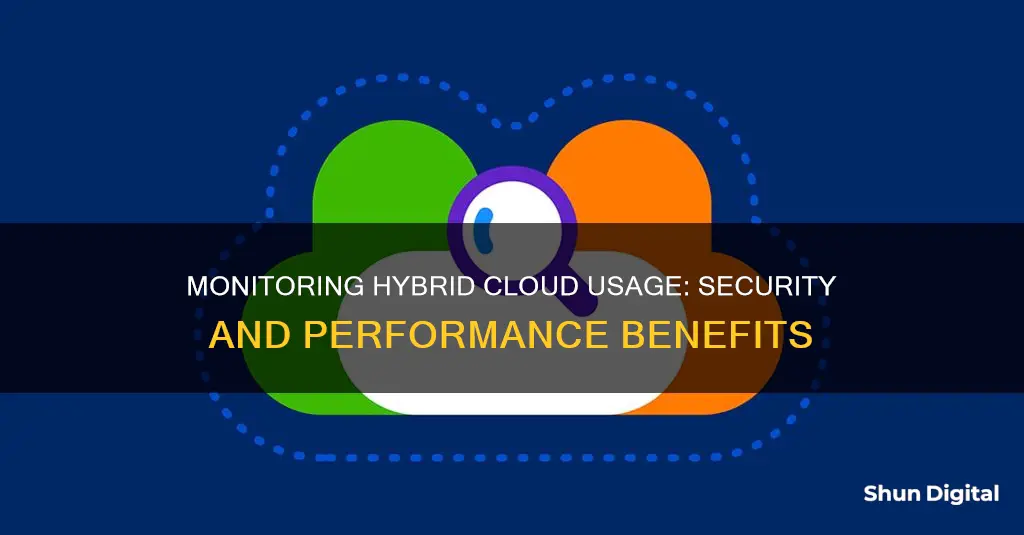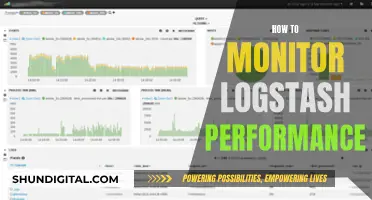
Hybrid cloud monitoring is essential to ensure that distributed applications are functional and secure, allowing businesses to use these resources as needed. Hybrid cloud monitoring can help consolidate performance metrics and troubleshooting data for assets across the hybrid environment into a single application, making it easier to resolve problems and make decisions about resources based on empirical evidence. Monitoring is critical to performance and security, and with the increased cloud usage, there is a greater need to monitor performance.
| Characteristics | Values |
|---|---|
| Benefits | Enhanced flexibility, cost optimisation, support for agile DevOps culture, improved security, improved productivity and performance |
| Challenges | Security and compliance, performance issues due to differences in private and public cloud SLAs, management and monitoring across complex hybrid architectures, limited visibility into public cloud components |
| Solutions | Standardise backend monitoring procedures, aggregate monitoring data into a single monitoring tier, create dashboards for comparing and displaying metrics, integrate monitoring systems with collaboration management tools, automate processes, use AI and ML to establish performance thresholds and identify anomalies |
What You'll Learn

To ensure consistent performance across environments
Hybrid cloud monitoring is critical to ensuring consistent performance across environments. In hybrid cloud infrastructures, workloads move between on-premises data centres and cloud environments based on business needs. Monitoring ensures that these transitions occur seamlessly, without sacrificing performance. Whether an application is running in a public cloud or on-premises, hybrid cloud monitoring allows teams to identify and address bottlenecks before they impact users.
Hybrid cloud monitoring solutions provide IT teams with insights into resource utilisation, network latency, application performance, and security issues, regardless of whether workloads are running on-premises or in the cloud. These tools collect and analyse data in real time, offering a centralised view of how well systems are functioning. This helps businesses ensure that their applications remain performant and responsive, providing users with a consistently high-quality experience.
One of the main challenges of hybrid cloud monitoring is achieving effective end-to-end monitoring of software and hardware stacks deployed across on-premises infrastructures and private and public clouds. The different components of a hybrid infrastructure often require different monitoring approaches and tooling, and it can be difficult to get so many disparate and complex systems to work together to provide meaningful, real-time insights.
Hybrid cloud monitoring tools help address this challenge by providing a unified view through a single dashboard. This allows IT teams to efficiently manage the complexity of multi-cloud and on-premises environments, enabling quicker identification of issues and faster resolution times.
By using hybrid cloud monitoring solutions, businesses can ensure consistent performance across environments, maintain security and compliance, optimise costs, and deliver a seamless user experience.
Monitoring GPU Performance: FPS, Temps, and Usage During Gameplay
You may want to see also

To manage network performance
Hybrid cloud monitoring is an important aspect of managing network performance. In a hybrid cloud setup, the network is a critical link between on-premises resources and the cloud. Monitoring network performance helps IT teams ensure optimal network health and uninterrupted data flow.
Network latency, bandwidth issues, and packet loss can impact the performance of applications. Hybrid cloud monitoring solutions, such as network performance monitoring (NPM) tools, help IT teams measure and manage these factors. These tools provide real-time data collection and analysis, offering a centralized view of system functionality.
For example, NetBeez runs network performance tests between private and public clouds, proactively detecting issues that slow down the network. This helps businesses confidently move their workloads to the public cloud.
By monitoring key network performance metrics, businesses can improve the performance of data transfers to and from the cloud. This includes monitoring latency, packet loss, and throughput to detect connectivity and performance issues.
Additionally, hybrid cloud monitoring can help identify and address bottlenecks before they impact users, ensuring consistent performance across environments. With the right monitoring tools, businesses can optimize costs, improve security, and deliver a seamless user experience.
Monitoring Virtual Memory Usage: A Comprehensive Guide
You may want to see also

To maintain security and compliance
Hybrid cloud monitoring is essential for maintaining security and compliance. With workloads spanning multiple environments, security becomes more complex. Hybrid cloud monitoring tools help ensure that security policies are enforced across both on-premises and cloud infrastructures. These tools also provide continuous monitoring for compliance with industry regulations, reducing the risk of breaches or non-compliance.
The average cost of a breach in a hybrid cloud environment is $3.61 million, highlighting the critical importance of data security. Organizations must consider data security and compliance during all stages of cloud usage and the data lifecycle. This includes migration to the hybrid cloud environment, where safeguarding practices should be a continuous and ingrained consideration at every level.
Hybrid cloud monitoring solutions offer a centralized view of system performance, enabling IT teams to gain insights into resource utilization, network latency, application performance, and security issues. This visibility helps identify and address bottlenecks before they impact users, ensuring consistent performance across environments.
- Develop a comprehensive security policy: Create a robust security policy tailored to the hybrid multi-cloud environment, encompassing data protection, access controls, incident response, and regulatory compliance.
- Implement strong access controls and authentication mechanisms: Utilize multi-factor authentication and role-based access controls to ensure only authorized individuals can access data and applications.
- Regularly monitor and audit security controls: Continuously monitor and audit security controls to detect vulnerabilities and anomalies, enabling prompt incident response and ensuring the effectiveness of security measures.
- Conduct regular risk assessments: Identify potential security risks and vulnerabilities through regular risk assessments, allowing for the prioritization of security measures and effective allocation of resources for risk mitigation.
- Ensure compliance with regulations: Stay up-to-date with relevant regulations and compliance requirements, including data privacy laws, industry-specific regulations, and international standards. Implement the necessary controls to maintain compliance.
- Encryption: Employ encryption to protect sensitive data, particularly when stored across multiple cloud platforms.
- Firewalls: Utilize firewalls to control traffic between different environments and enhance security.
- Security Information and Event Management (SIEM) tools: Leverage SIEM tools to monitor suspicious activities and enhance threat detection capabilities.
- Disaster recovery plan: Develop a comprehensive disaster recovery plan that accounts for human errors to ensure business continuity in the event of disruptions.
- Shared security responsibility: Foster a shared security responsibility model where both the cloud provider and the customer work together to secure the environment.
Monitoring Individual Data Usage: Router Firmware Options
You may want to see also

To provide unified management for complexity
Hybrid cloud monitoring is critical to ensure optimal performance and security across an organization's infrastructure. By providing a unified management system, hybrid cloud monitoring simplifies the complexities of managing disparate systems. This is achieved through:
Single Dashboard View
A single dashboard interface offers a unified view of the entire hybrid infrastructure, including on-premises and cloud-based resources. This centralized view enables IT teams to efficiently manage and monitor the performance of diverse systems, gaining insights into resource utilization, network latency, application performance, and security issues.
Enhanced Troubleshooting and Resolution
The unified management approach of hybrid cloud monitoring improves the identification and resolution of issues. With a comprehensive view of the infrastructure, IT teams can quickly pinpoint problems and take appropriate actions, reducing resolution times. This ensures seamless transitions during workload shifts between on-premises data centers and cloud environments.
Automation and Efficiency
Hybrid cloud monitoring solutions provide automation capabilities that streamline provisioning, monitoring, and routine tasks. This reduces manual interventions, increases efficiency, and minimizes errors. Automation also enables dynamic resource provisioning, allowing cloud resources to scale up or down based on demand, optimizing costs and ensuring businesses pay only for the resources they need.
Performance Optimization
By continuously tracking and analyzing performance metrics, hybrid cloud monitoring helps maintain consistent performance across environments. IT teams can identify bottlenecks and address them proactively, ensuring applications remain performant and responsive, regardless of the underlying infrastructure. This, in turn, enhances the user experience and helps maintain a high-quality user experience in a competitive market.
Security and Compliance
With workloads spanning multiple environments, security and compliance become more complex. Hybrid cloud monitoring tools provide centralized security management, ensuring consistent enforcement of security policies across on-premises and cloud infrastructures. Continuous monitoring for compliance with industry regulations reduces the risk of breaches and ensures adherence to regulatory standards.
In conclusion, hybrid cloud monitoring provides unified management by offering a single dashboard view, enhancing troubleshooting capabilities, automating routine tasks, optimizing performance, and strengthening security and compliance. This unified approach simplifies the complexities of managing hybrid infrastructures, enabling IT teams to efficiently oversee and orchestrate diverse resources.
Monitoring Internet Usage: Boost Mobile's Data Insights
You may want to see also

To deliver a better user experience
Hybrid cloud monitoring is an important practice for businesses to adopt to deliver a better user experience. Hybrid cloud monitoring refers to the continuous tracking and analysis of performance, availability, and health of applications and services running across both on-premises environments and public/private cloud infrastructures. By adopting hybrid cloud monitoring, businesses can ensure that their applications are performant and responsive, providing users with a consistently high-quality experience.
Hybrid cloud monitoring tools provide IT teams with valuable insights into resource utilisation, network latency, application performance, and security issues, regardless of whether workloads are running on-premises or in the cloud. These tools enable IT teams to identify and address bottlenecks before they impact users, ensuring seamless transitions between on-premises data centres and cloud environments.
One of the key benefits of hybrid cloud monitoring is its ability to provide a unified view of the entire infrastructure through a single dashboard. This simplifies the management of complex, multi-cloud, and on-premises environments, leading to quicker issue identification and faster resolution times. With hybrid cloud monitoring, businesses can easily track metrics and identify bottlenecks or failures in the transaction stack across all layers of their IT environment.
Additionally, hybrid cloud monitoring helps businesses optimise costs by providing insights into cloud resource consumption. This prevents over-provisioning and ensures businesses only pay for the resources they need. By leveraging hybrid cloud monitoring solutions, businesses can strike a balance between on-premises control and cloud scalability, delivering a seamless user experience while maintaining optimal performance, security, and compliance.
To achieve effective hybrid cloud monitoring, businesses should consider implementing Artificial Intelligence (AI) and Machine Learning (ML) methods. These technologies can establish thresholds for acceptable performance, automatically identify anomalies, and raise smart alerts. By integrating AI and ML into their monitoring practices, businesses can further enhance their ability to deliver a superior user experience by ensuring the optimal performance of their applications and infrastructure.
Battery-Sapping Security Apps: Monitor Your Usage
You may want to see also
Frequently asked questions
Monitoring usage of hybrid cloud is important to ensure consistent performance across environments, manage network performance, maintain security and compliance, and provide a unified management system for complexity.
Monitoring usage of hybrid cloud can help identify and address bottlenecks before they impact users, ensure optimal network health and uninterrupted data flow, and reduce the risk of breaches or non-compliance.
Monitoring usage of hybrid cloud can be challenging due to the need for different monitoring approaches and tooling for the various components of a hybrid infrastructure, limited visibility into public cloud components, and the complexity and scale of hybrid environments.
There are various tools and solutions available for monitoring hybrid cloud usage, including third-party solutions, public cloud provider monitoring services, and free or basic monitoring tools. These tools can help aggregate and analyze data from multiple sources and provide real-time visibility into the performance and health of applications.







